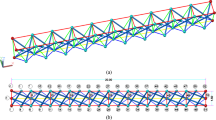Abstract
An energy-based semi-active control strategy is presented to reduce structural vibration. The equation of motion is derived from a structure-TLCD coupled system. Material and geometrical nonlinearities have been considered in the 3D irregular system. The rigid floors and plan irregularity in the system are assumed. An on-off control orifice is located in the middle of the U-shaped tube TLCD system. The El-Centro 1940 earthquake excitation record is employed to train the algorithm, and two other earthquake excitations are applied to evaluate the performance of the proposed method. The results show that the RMS values of displacement and acceleration responses of the structure reduced significantly under seismic excitations.
Similar content being viewed by others
References
Agrawal, A. K. and Yang, J. N. (1996). “Optimal polynomial control of seismically excited linear structures.” Journal of Engineering Mechanics, ASCE, Vol. 122, No. 8, pp. 753–761.
Ahmadizadeh, M. (2007). “On equivalent passive structural control system for semi-active control using viscous fluid dampers.” Journal of Structural Control and Health Monitoring, Vol. 14, pp. 858–875, DOI: 10.1002/stc.182.
Baber, T. T. amd Wen, Y. K. (1981). “Random vibration of hysteretic degrading systems.” Journal of Engineering MechanicsE, ASC, Vol. 107, No. 6, pp. 1069–1087.
Chu, S. Y., Soong, T. T., Reinhorn, A. M., Helgeson, R. J., and Riley, M. A. (2002). “Integration issues in implementation of structural control systems.” Journal of Structural Control, Vol. 9, pp. 31–58 DOI: 10.1002/stc.2.
Huang, K., Betti, R., and Ettouney, M. (1999). “Instantaneous optimal control for seismic analysis of non-linear structures.” Journal of Earthquake Engineering, Vol. 3, No. 1, pp. 83–106.
Jiang, X. and Adeli, H. (2008). “Dynamic fuzzy wavelet neuroemulator for non-linear control of irregular building structures.” International Journal for Numerical Methods in Engineering, Vol. 74, pp. 1045–1066.
Karnopp, D., Crosby, M. J., and Harwood, R. A. (1974). “Vibration control using semi-active force generators.” ASME J. Eng. Ind., Vol. 96, No. 2, pp. 619–26.
Kim, D. H. and Lee, I. W. (2001). “Neuro-control of seismically excited steel structure through sensitivity evaluation scheme.” Earthquake Engineering and Structural Dynamics, Vol. 30, pp. 1361–1377, DOI: 10.1002/eqe.67.
Lafontaine, M., Moroni, O., Sarrazin, M., and Roschke, P. (2009). “Optimal control of accelerations in a base-isolated building using magnetorheological dampers and genetic algorithms.” Journal of Earthquake Engineering, Vol. 13, No. 8, pp. 1153–1171.
Lee, T. Y. and Chen, P. C. (2011). “Experimental and analytical study of sliding mode control for isolated bridges with MR dampers.” Journal of Earthquake Engineering, Vol. 15, No. 4, pp. 564–581.
Li, J., Peng, Y. B., and Chen, J. (2008). “GDEE-based stochastic control strategy of MR damping systems.” Proc. of the Tenth International Symposium on Structural Engineering for Young Experts, Changsha, China, pp. 1207–1212.
Lyons, J. L. (1982). Lyon’s valve designer’s handbook, Van Nostrand Reinhold Co.
MATLAB (2008). The language of technical computing, Math Works Inc.: MA.
Ohtori, Y., Christenson, R. E., Spencer, B. F., and Dyke, S. J. (2004). “Benchmark control problems for seismically excited nonlinear buildings.” J. Eng., Mech., Vol. 130, p. 366, DOI:10.1061/(ASCE), 0733-9399, 2004,130:4(366).
Pourzeynali, S., Lavasani, H., and Modarayi, A. H. (2007). “Active control of high rise building structures using fuzzy logic and genetic algorithms.” Engineering Structures, Vol. 29, No. 3, pp. 346–357.
Sakai, F., Takaeda, S., and Tamaki, T. (1991). “Tuned Liquid Column Damper (TLCD) for cable-stayed bridges.” Proceeding of Specialty Conf. Invitation in Cable-stayed Bridges, Fukuoka, Japan, pp. 197–205.
Samali, B. and Al-Dawod, M. (2003). “Performance of a five-storey benchmark model using an active tuned mass damper and a fuzzy controller.” Engineering Structures, Vol. 25, pp. 1597–1610.
Sarbjeet, S. and Datta, T. K. (2003). “Sliding mode control of building frames under random ground motion.” Journal of Earthquake Engineering, Vol. 7, No. 1, pp. 73–95.
Soong, T. T. (1991). Active structural control theory and practice, Longman and Wiley, London and New York.
Stein, G. and Athans, M. (1987). “The LQG/LTR procedure for multivariable feedback control design.” IEEE Transactions on Automatic Control, Vol. AC32, No. 2, pp. 105–114.
Wang, Z. H, Chen, Z. Q., and Spencer, B. F., (2009). “Self-powered and sensing control system based on MR damper: presentation and application.” Proc. SPIE Smart structures/NDE, San Diego, California.
Won, A. Y. J., Pires, J. A., and Haroun, M. A. (1996). “Stochastic seismic performance evaluation of tuned liquid column dampers.” Earthquake Engineering & Structural Dynamics, Vol. 25, No. 11, pp. 1259–1274.
Yalla, S. K. and Kareem, A. (2000). “Optimal absorber parameters for tuned liquid column dampers.” J. Struct. Eng., ASCE, Vol. 126, No. 8, pp. 906–915.
Yalla, S. K., Kareem, A., and Kantor, J. C. (2001). “Semi-active tuned liquid column dampers for vibration control of structures.” Engineering Structures, Vol. 23, pp. 1469–1479.
Author information
Authors and Affiliations
Corresponding author
Rights and permissions
About this article
Cite this article
Bigdeli, Y., Kim, D. Response control of irregular structures using structure-TLCD coupled system under seismic excitations. KSCE J Civ Eng 19, 672–681 (2015). https://doi.org/10.1007/s12205-013-1019-0
Received:
Revised:
Accepted:
Published:
Issue Date:
DOI: https://doi.org/10.1007/s12205-013-1019-0




